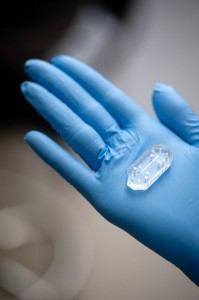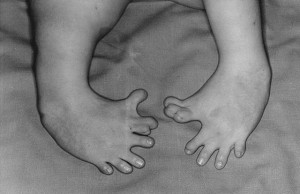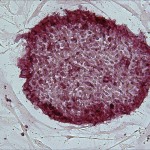
It may not look like it, but it's a lung, just in chip form.
They don’t look like much sitting in your hand. A few pieces of clear plastic, each smaller than an Altoids tin, with channels visible inside and holes for plugging tubing into them.
But fill them with cells and treat those cells the right way, and they turn into something amazing: tiny hearts, lungs, guts, kidneys.
They’re “organs on chips,” and they represent what’s probably the most comprehensive effort to date to physically model the functions of whole organs for drug development and disease research.
Developed by a team of biologists and engineers led by Donald Ingber, MD, PhD, a member of Boston Children’s Hospital’s Vascular Biology Program and director of the Wyss Institute for Biologically Inspired Engineering at Harvard, they’re the building blocks for an ambitious project to create an artificial multi-organ system—essentially, a whole body on a chip. Full story »

Chromosome 15. Image: Wikimedia Commons
Angelman syndrome (AS) is a rare, neurogenetic condition characterized by severe developmental delay, movement disorder, speech impairment (often with a complete lack of speech) and an unusually happy demeanor. Nearly every individual with AS faces at least two major challenges in their daily life: cognitive or intellectual disability, and movement disorder, usually in the form of ataxic (uncoordinated) gait, unsteadiness, jerky movements or tremors. Seizures are also common, and present a daunting health challenge.
Arising in one out of every 10,000 to 20,000 children from the loss of an enzyme on chromosome 15 called Ube3A, AS falls in the category of orphan diseases: ones that affect fewer than one in 200,000 Americans. There is no cure for AS, but there are therapies and medications that can help the symptoms. Seizures can be controlled with the right medications, physical therapy can improve ataxia, and speech therapy helps improve communication skills.
Like nearly all orphan diseases, research on AS has historically not been well-funded, but orphan diseases have lately gained growing attention, especially at Children’s Hospital Boston. Full story »

Congenital malformation of the feet caused by thalidomide.
The question comes up when a pregnant woman has a serious medical condition: should she or shouldn’t she be treated? Are the indicated drugs safe for the baby?
Drugs are assigned pregnancy risk classes. Thalidomide, whose reputation for causing fetal malformations was chillingly established in the 1960s, is solidly in Class X (the most risky), as are the cholesterol-lowering drug lovastatin and the anti-coagulant warfarin. At the other extreme are Class A drugs that are widely recognized as safe in pregnancy.
But between these extremes is a huge group of drugs for which little is known. Full story »
 People with autism and most other disorders of brain development have never had medications to treat their core behavioral and cognitive symptoms. The best they can get are drugs targeting secondary problems, like irritability or aggression. But now, a new wave of clinical trials, such as the one we posted about yesterday for Rett syndrome, aims to change this.
People with autism and most other disorders of brain development have never had medications to treat their core behavioral and cognitive symptoms. The best they can get are drugs targeting secondary problems, like irritability or aggression. But now, a new wave of clinical trials, such as the one we posted about yesterday for Rett syndrome, aims to change this.
In the last decade, scientists have discovered many of the molecular pathways in genetic disorders that can impair cognition and place a child on the autism spectrum—such as tuberous sclerosis complex, Rett syndrome, Fragile X syndrome and Angelman syndrome. These discoveries are suggesting targets for drug treatment, and is changing how these conditions—and perhaps neurodevelopmental disorders generally—are viewed. Full story »

This urine test gives a numerical readout that TB patients can text to clinicians.
The number of mobile phone subscriptions worldwide is approaching 5 billion, many of them in developing countries where cell phones are the most reliable communications platform. So it’s no wonder that they’re becoming a global health tool to combat diseases like tuberculosis and AIDS.
In a recently reported trial in Kenya, for example, HIV patients who were texted weekly on their cell phones Full story »
 Within five years, likely well before we start treating patients with their own genetically corrected stem cells created from induced pluripotent stem cells, I am expecting to see new drugs discovered using iPS cells enter the clinical pipeline.
Within five years, likely well before we start treating patients with their own genetically corrected stem cells created from induced pluripotent stem cells, I am expecting to see new drugs discovered using iPS cells enter the clinical pipeline.
It’s only been two years since three labs (ours included) created the first human iPS cells through genetic reprogramming of skin cells. Full story »
Combining microfabrication techniques from the computer industry with modern tissue engineering, a team at Children’s Hospital Boston and Harvard’s Wyss Institute for Biologically Inspired Engineering has created a device that mimics the function of a human lung. This living “lung-on-a-chip,” which incorporates human lung and blood-vessel cells, reproduces the all-important interface between the lung’s tiny air sacs and the bloodstream. Breathing is simulated with a vacuum pump.
The wafer-sized device mimics the human lung’s response to infectious agents, airborne particles and toxins in a way that’s truer to real life than standard cell testing in a lab dish. Full story »














